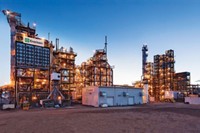Advertisement
Grab your lab coat. Let's get started
Welcome!
Welcome!
Create an account below to get 6 C&EN articles per month, receive newsletters and more - all free.
It seems this is your first time logging in online. Please enter the following information to continue.
As an ACS member you automatically get access to this site. All we need is few more details to create your reading experience.
Not you? Sign in with a different account.
Not you? Sign in with a different account.
ERROR 1
ERROR 1
ERROR 2
ERROR 2
ERROR 2
ERROR 2
ERROR 2
Password and Confirm password must match.
If you have an ACS member number, please enter it here so we can link this account to your membership. (optional)
ERROR 2
ACS values your privacy. By submitting your information, you are gaining access to C&EN and subscribing to our weekly newsletter. We use the information you provide to make your reading experience better, and we will never sell your data to third party members.
Environment
Giant Wood-To-Diesel Plant Planned For Finland
Advanced biofuel: Chinese firm says it will spend $1 billion on Fischer-Tropsch facility
by Melody Bomgardner
February 12, 2016

The Chinese bioenergy firm Sunshine Kaidi New Energy Group says it plans to spend $1 billion or more to build a plant in Kemi, Finland, that will transform woody raw materials into diesel and gasoline.
The firm has formed a local company, Kaidi Finland, to establish the larger project, which it calls the first of its kind in the world. It would produce 200,000 metric tons of fuel per year, of which 75% would be diesel and 25% gasoline. Kemi is in the northern part of Finland, near a deep water harbor in the Baltic Sea; Kaidi plans to distribute the biofuels throughout Europe.
The Fischer-Tropsch process was developed by Germany during World War II to make transportation fuels from biomass. It requires a large, expensive gasifier to convert organic matter into synthesis gas. The syngas is then cleaned in a scrubber. The remaining H2 and CO are reacted with catalysts to make liquid hydrocarbons.
In the modern era, the technology is used to convert coal and natural gas to liquids, particularly in China. But matching the required scale of a gasifier with sufficient quantities of local biomass has to date made Fischer-Tropsch uneconomical for biofuel production. Still, Finland has a lot of trees—its forestry industry has been in decline due to the fall in global demand for paper products.
“We find Finland the most interesting country to invest in for biofuels production in the Northern hemisphere. Finland has vast biomass resources, plenty of potential partner companies, and an extremely progressive biofuels policy,” says Chen Yilong, Chief Executive Officer of Sunshine Kaidi.
Kaidi currently operates a biodiesel pilot plant in Wuhan, China. It will make the final decision to build in Finland by the end of this year.
Similar attempts by other firms have not been successful. In the U.S., start-up KiOR planned to make fuels via pyrolysis but went bankrupt. And Range Fuels was unable to make ethanol from its gasification plant in Georgia. Another firm, Joule Unlimited, is planning to build a smaller version of a Fischer-Tropsch facility in Oregon.
Large Chinese chemical firms have been looking abroad to invest in places with abundant raw materials. In 2014, a consortium called NW Innovation Works said it would spend $5.4 billion to build three methanol plants in Oregon and Washington and ship the product to China for petrochemical production.
Given current low oil prices and the slowing of economic growth in China, large new commodity investments may not pan out. But there will be demand for the biofuel in Europe. Last year, the European Union set a target to obtain 0.5% of fuel from advanced biofuel processes such as gasification. In 2012, 22.6% of biodiesel used in the EU was imported.




Join the conversation
Contact the reporter
Submit a Letter to the Editor for publication
Engage with us on Twitter